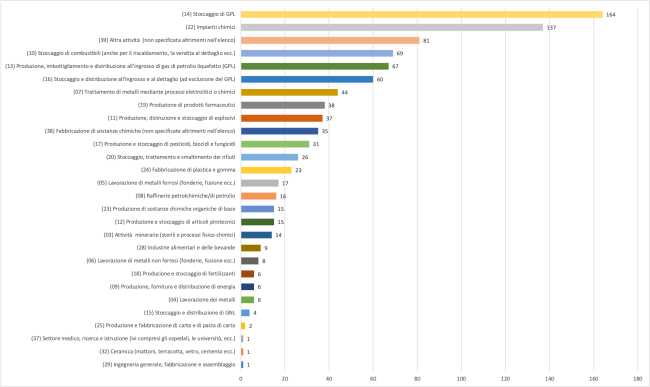Panel 1
Fabrizio Vazzana, Francesca Pepe
The indicator analyzes the distribution of all industrial activities across the country according to the categories defined in Legislative Decree 105/2015 for establishments at risk of major accidents. The analysis of establishment types allows for a qualitative mapping of industrial risk in our country. The legislation divides establishments into 38 activity categories plus a thirty-ninth category (other) comprising all activities not included in the previous categories, based on the NACE code, a general classification system used to systematize and standardize the definitions of economic/industrial activities in the various European Union member states. Specifically, as of June 30, 2025, the total number of establishments at risk of major accidents is 932, a slight decrease of 1 compared to December 2024. Regarding the type of activities present across the country, the prevalence of "LPG storage" depots (1°) and "chemical plants" (2°) is observed. These are followed by the so-called "Other activities, unspecified" (3rd), "Storage of fuels (including for heating, retail sale, etc.)" (4th), and "Production, bottling, and wholesale distribution of liquefied petroleum gas (LPG)" (5th). Together, these constitute approximately 50% of all establishments. These are followed by "Storage and wholesale and retail distribution (excluding LPG)" (6th), "Treatment of metals by electrolytic or chemical processes" (7th), "Production of pharmaceutical products" (8th), and "Production, destruction, and storage of explosives" (9th). These are followed by "Manufacture of chemical substances (not otherwise specified in the list)" (10th), "Production and storage of pesticides, biocides, and fungicides" (11th), and "Storage, treatment, and disposal of waste" (12th).
From the analysis of the types of establishments it is possible to obtain important information on the industrial risk map in our country. The activity of an establishment allows, in fact, to know in advance, albeit in a qualitative way, the potential associated danger. The new regulation divides the Seveso establishments into 38 categories of activities plus a thirty-ninth category (other) including all the activities not included in the previous ones, on the basis of the NACE code, a general classification system used to systematize and standardize the definitions of economic/industrial activities in the various member states of the European Union. From the belonging of an establishment to one of the above-mentioned categories it is possible to know in advance the risks associated with it. The storage depots of fuels and liquefied gases and the depots of explosives and pyrotechnic articles are characterized, for example, by a prevalent risk of fire and/or explosion with effects attributable, in the event of an accident, mainly to radiation and more or less high overpressure and therefore to structural damage to the plants and buildings and physical damage to humans. Chemical plants, pharmaceutical production plants, pesticide, biocide and fungicide storage depots combine the risk of fire and/or explosion, like the previous ones, with the risk of spreading toxic substances, even at a distance, and therefore the possibility of immediate and/or delayed dangers for humans and the environment. Metal processing and treatment plants and waste storage, treatment and disposal plants are instead normally characterized by a prevalent risk of environmental damage and consequently indirect damage to human health.
Estimate the prevalent nature of the risks to which they are subject: man, air, soil, subsoil, groundwater and surface water, in relation to the presence of certain types of establishments at risk of major accidents.
D.Lgs. 105/2015
Panel 2
ISPRA-MASE, Inventario Seveso ISPRA, Annuario dei dati ambientali - Vari anni
Depending on the speed with which the information reaches ISPRA, it is now subject to evaluation.
None
Data quality assessment
National inventory of establishments likely to cause major accidents, as provided for by Article 5, paragraph 3 of Legislative Decree 105/2015.
https://www.rischioindustriale.isprambiente.gov.it/seveso-query-105/Default.php
National
2019-2024
Indicator assessment
All information is taken from the National Inventory of establishments likely to cause major accidents, provided for by Article 5, paragraph 3 of Legislative Decree 105/2015. The inventory allows the extraction of an Excel file that allows to extrapolate after different steps, the data necessary for updating the indicator.
As of June 30, 2025, the number of establishments is 932; those in the lower threshold are 440, while those in the upper threshold are 492.
Si evidenziano lievi variazioni del numero e del tipo di industrie sottoposte agli obblighi imposti dalla normativa “Seveso”. Al giugno 2025, il numero di stabilimenti rileva una lieve flessione, non significativa per la quantificazione di un trend specifico (932 rispetto ai 933 dell'anno precedente). Dal 2019 al dicembre 2025 gli stabilimenti sono passati da 991 a 932, con una riduzione pari a circa il 5%.

Regarding the type of activities present in the country, the prevalence is found in "LPG storage" (1°) and "chemical plants" (2°). This is followed by the so-called "Other activities, unspecified" (3°), "Fuel storage (including for heating, retail sale, etc.)" (4°), and "Production, bottling, and wholesale distribution of liquefied petroleum gas (LPG)" (5°). Together, these constitute approximately 50% of the total number of establishments with a major accident risk present in the country (Figure 1). This is followed by "Wholesale and retail storage and distribution (excluding LPG)" (6°), and "Metal treatment using electrolytic or chemical processes" (7°), "Production of pharmaceutical products" (8°), and "Production, destruction, and storage of explosives" (9°). These are followed by facilities for the "manufacture of chemical substances (not otherwise specified in the list)" (10th), "production and storage of pesticides, biocides, and fungicides" (11th), and "waste storage, treatment, and disposal" (12th). As can be seen from Table 1, the changes are minimal, so it seems likely that since the entry into force of Legislative Decree 105/2015, following the transition to Legislative Decree 334/99, which led to a significant decrease in the number of facilities subject to the regulation, a situation of substantial stability has been observed, albeit with a slight reduction over the years.